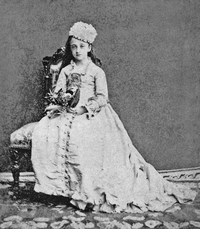Nazime Sultan
| Nazime Sultan | |
|---|---|
 | |
| Born | 25 February 1867 Dolmabahçe Palace, Constantinople, Ottoman Empire (now Istanbul, Turkey) |
| Died | 9 November 1947 (aged 80) Jounieh, Lebanon |
| Burial | |
| Spouse |
Ali Halid Pasha
(m. 1889–1947) |
| Dynasty | Ottoman |
| Father | Abdulaziz |
| Mother | Hayranidil Kadın |
| Religion | Sunni Islam |
Nazime Sultan (
Early life
Nazime Sultan was born on 25 February 1867[1] in at the Dolmabahçe Palace.[2] Her father was Sultan Abdulaziz, and her mother was Hayranidil Kadın. She was the second daughter of her father and the first child of her mother. She was the elder full sister of the future Caliph Abdulmejid II.[3][4] She was the granddaughter of Mahmud II and Pertevniyal Sultan.[5]
Her father, Abdulaziz was deposed by his ministers on 30 May 1876, his nephew Murad V became the Sultan.[6] He was transferred to Feriye Palace the next day.[7] Her mother, and other women of Abdulaziz's entourage didn't want to leave the Dolmabahçe Palace. So they were grabbed by hand and were sent out to the Feriye Palace. In the process, they were searched from head to toe and everything of value was taken from them.[8] On 4 June 1876,[9] Abdulaziz died under mysterious circumstances.[10]
Nazime Sultan, a ten-year-old girl, continued to live in the Feriye Palace with her mother and eight-year-old brother.[11] Recounting the event in an interview to Adil Sulh Bey years later, Nazime said:[12]
Any claims that my father committed suicide are deceitful. I saw it with my own eyes that they murdered my father.[13]
Marriage
In 1889 Sultan Abdul Hamid II arranged her trousseaux and marriage together with her two sisters, princesses
The couple were given a palace located at Kuruçeşme, known as Nazime Sultan Palace, as their residence.[15] Here she had performers of religious music.[16] She did not have any children.
Philanthropy
Müdafaa-i Milliye Hanımlar Cemiyeti (Woman's Chapter of the Society of National Defense), an organization was established in September 1912 and went to Istanbul to take care of people wounded in the
In 1912, the "Hilal-i Ahmer Centre for Women" was organized within the "Ottoman Hilal-i Ahmer Association", a foundation established in 1877 to provide medical care in Istanbul and surrounding communities.
Exile
Following the imperial family was sent to exile in 1924, Nazime and her husband settled in Jounieh, Lebanon.[5] Here the two lived in a large mansion surrounded by garden.[20]
When
According to Neslişah Sultan, she was tiny, rather ugly, with large lips like her father's, but quite impressive.[20]
Death

Nazime died on 9 November 1947 in Jounieh, Lebanon. She was the last surviving child of Abdulaziz. She was buried in the cemetery of the Sulaymaniyya Takiyya, Damascus, Syria. Her husband outlived by one year, and died in 1948 in Mecca, Saudi Arabia.[5]
Honours
| Styles of Nazime Sultan | ||
|---|---|---|
Reference style Her Imperial Highness | | |
| Spoken style | Your Imperial Highness | |
- Order of the House of Osman[21]
- Order of the Medjidie, Jeweled[21]
- Order of Charity, 1st Class[21]
Ancestry
| Ancestors of Nazime Sultan | ||||||||||||||||||||||||||||||||||||||||||||||||||||||||||||||||||||||||||||||||||||||||||||||||||||||||||||||||||||||||||||||||||||||||||||||||||||||||||||||||||||||||||||||||||||||||||||||||||||||||||||||||||||||||||||||||||||||
|---|---|---|---|---|---|---|---|---|---|---|---|---|---|---|---|---|---|---|---|---|---|---|---|---|---|---|---|---|---|---|---|---|---|---|---|---|---|---|---|---|---|---|---|---|---|---|---|---|---|---|---|---|---|---|---|---|---|---|---|---|---|---|---|---|---|---|---|---|---|---|---|---|---|---|---|---|---|---|---|---|---|---|---|---|---|---|---|---|---|---|---|---|---|---|---|---|---|---|---|---|---|---|---|---|---|---|---|---|---|---|---|---|---|---|---|---|---|---|---|---|---|---|---|---|---|---|---|---|---|---|---|---|---|---|---|---|---|---|---|---|---|---|---|---|---|---|---|---|---|---|---|---|---|---|---|---|---|---|---|---|---|---|---|---|---|---|---|---|---|---|---|---|---|---|---|---|---|---|---|---|---|---|---|---|---|---|---|---|---|---|---|---|---|---|---|---|---|---|---|---|---|---|---|---|---|---|---|---|---|---|---|---|---|---|---|---|---|---|---|---|---|---|---|---|---|---|---|---|---|---|
| ||||||||||||||||||||||||||||||||||||||||||||||||||||||||||||||||||||||||||||||||||||||||||||||||||||||||||||||||||||||||||||||||||||||||||||||||||||||||||||||||||||||||||||||||||||||||||||||||||||||||||||||||||||||||||||||||||||||
See also
References
- ^ Uçan, Lâle (2019). Dolmabahçe Sarayı'nda Çocuk Olmak: Sultan Abdülaziz'in Şehzâdelerinin ve Sultanefendilerinin Çocukluk Yaşantılarından Kesitler. FSM İlmî Araştırmalar İnsan ve Toplum Bilimleri Dergisi. p. 232.
- ^ Brookes 2010, p. 286.
- ^ a b Uluçay 2011, p. 225.
- ^ a b Sakaoğlu 2008, p. 645.
- ^ a b c d Adra, Jamil (2005). Genealogy of the Imperial Ottoman Family 2005. pp. 16.
- ISBN 978-1-850-43399-6.
- ISBN 978-0-521-29166-8.
- ^ Brookes 2010, p. 40.
- ISBN 978-1-400-87876-5.
- ^ Brookes 2010, p. 43.
- ISBN 978-9-750-80883-8.
- ^ Ömer Faruk Yılmaz (27 September 2011), "Abdülaziz Han'ın kızı: Babamın katledilişini gördüm", www.timeturk.com, retrieved 22 October 2020
- ^ Harun Yahya, Adnan (2017). Mastermind: The truth of the British Deep State Revealed. Araştırma Publishing. p. 263.
- ^ Brookes 2010, p. 159.
- ISBN 978-0-847-81989-8.
- ISBN 978-0-313-24811-5.
- ^ Atamaz-Hazar, Serpil (2010). The Hands that Rock the Cradle will Rise: Women, Gender, and Revolution in Ottoman Turkey, 1908-1918. University of Arizona. pp. 94–95.
- ISBN 978-9-004-21217-6.
- ^ Os, Nicolina Anna Norberta Maria van (31 October 2013). Feminism, Philanthropy and Patriotism: Female Associational Life in the Ottoman Empire. Leiden University Institute for Area Studies (LIAS), Faculty of Humanities, Leiden University. pp. 449–450.
- ^ ISBN 978-9-774-16837-6.
- ^ a b c Yılmaz Öztuna (1978). Başlangıcından zamanımıza kadar büyük Türkiye tarihi: Türkiye'nin siyasî, medenî, kültür, teşkilât ve san'at tarihi. Ötüken Yayınevi. p. 165.
Sources
- Brookes, Douglas Scott (2010). The Concubine, the Princess, and the Teacher: Voices from the Ottoman Harem. University of Texas Press. ISBN 978-0-292-78335-5.
- Sakaoğlu, Necdet (2008). Bu mülkün kadın sultanları: Vâlide sultanlar, hâtunlar, hasekiler, kadınefendiler, sultanefendiler. Oğlak Yayıncılık. ISBN 978-9-753-29623-6.
- Uluçay, Mustafa Çağatay (2011). Padişahların kadınları ve kızları. Ankara: Ötüken. ISBN 978-9-754-37840-5.

